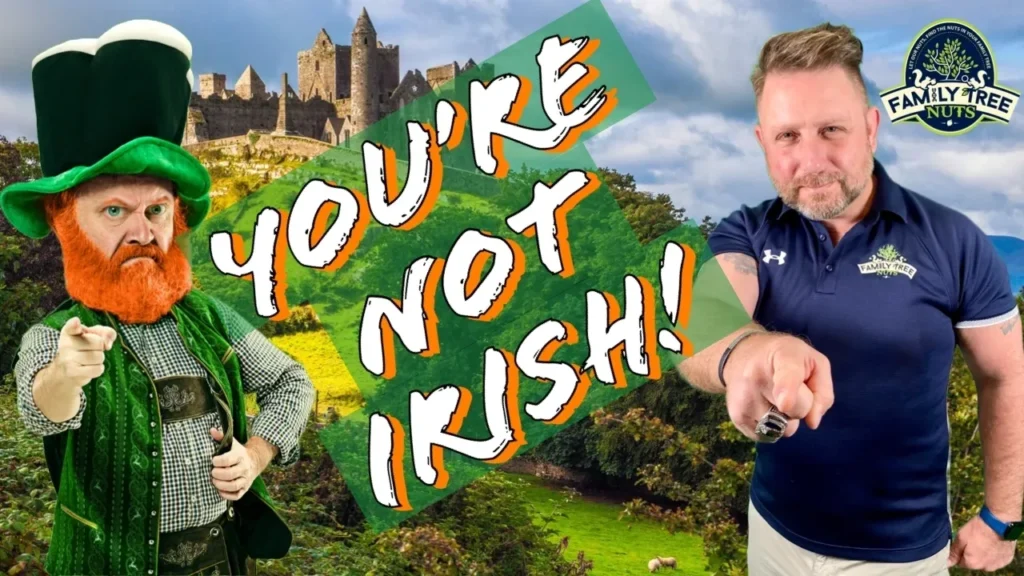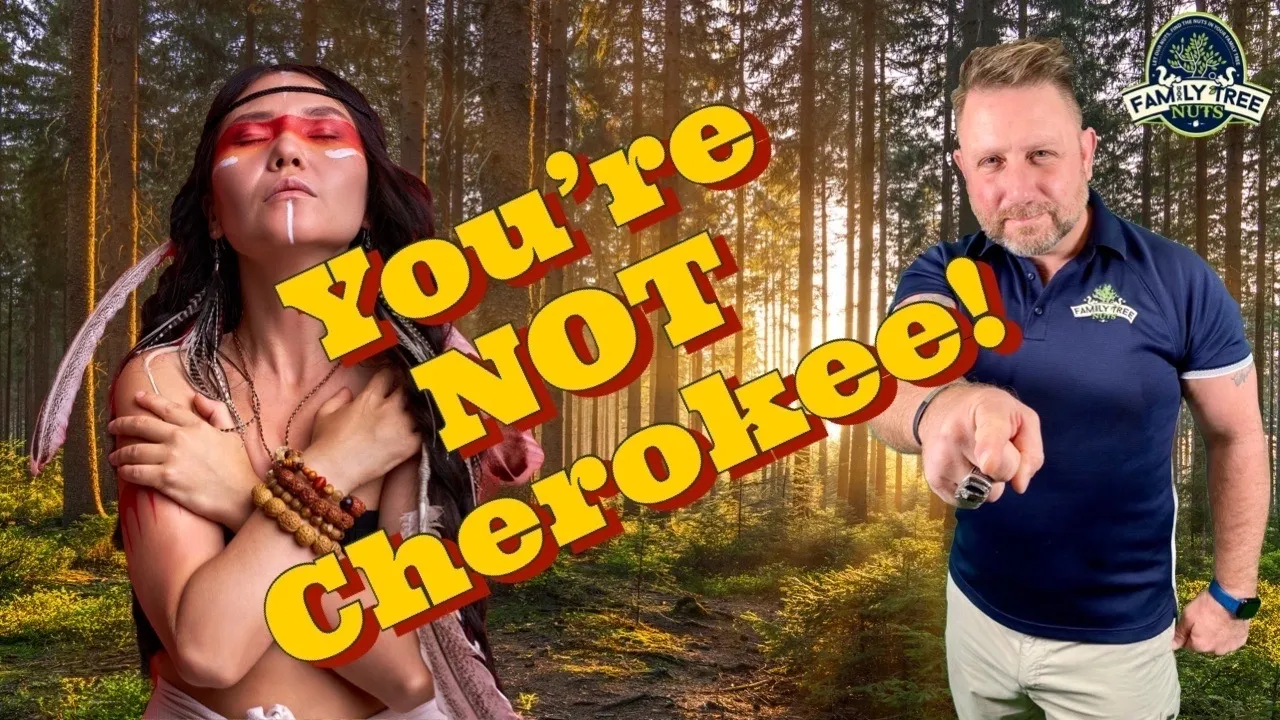
NO! You are NOT Cherokee! The biggest myth in genealogy!
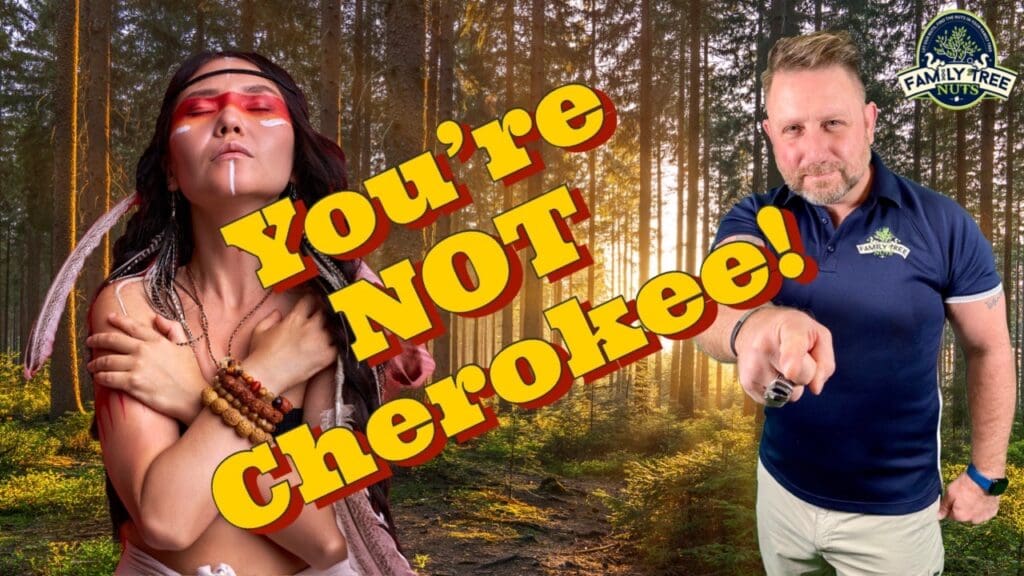
No! You are NOT Cherokee! Your Great-Great Grandma was NOT full-blooded Cherokee, nor was she a Cherokee Princess! I know that I am going to make a ton of people mad here and before the end of this story there are many of you that will think I’m completely crazy, but I don’t care, I’m going to tell it like it is. As much as you may WANT it to be true or even fantasize that it is true, the facts are, millions of us have believed in a fallacy our whole lives.
Before I go too much farther in explaining why you don’t have racial attachment to those dream catchers above your beds, and that howling wolf with the Indian chief on your t-shirt, I need to be clear on something. Some of you, a very small percentage that claim it, actually do have Native American ancestors, and even a smaller amount of you even have a one or more Cherokee ancestors. For those very few, this story does not apply, but for the remaining MILLIONS of you out there, I’m going to explain how this misconception came about and why so many believe it.

Also, let me be perfectly clear for those that love to drop descriptive titles on people, I one hundred percent respect the first peoples of this continent. I respect their culture and traditions. This video is not anti-Cherokee, or anti-Native, it is intended to shed some light on one of the most common myths in genealogy. No matter who your ancestors are, you should honor and celebrate them.
If I had a nickel… If I had a nickel for every time as a genealogist, when I’ve asked someone what their ethnic makeup was, they told me various European countries and then inevitably drop the word Cherokee. It’s been a source of amusement for those in my circle, and when we hear this, we look at each other with an understanding inside joke. It’s almost always their great-great-grandmother who is the one who was “Full-Blooded Cherokee”, which is interesting, and I’ve got some reasons as to why that is that I’ll explain later in this article. I have heard this myth in my own family and I know several of them are going to be furious when they see this article, but the reality is, they need to know that we just don’t have any Cherokee in us. At least not anymore.
Why do so many folks think they have Cherokee Blood? Where did this myth come from? Why is it so prevalent in the families in Appalachia? Why is it so prevalent in folks from the South? Why is it prevalent in many black families as well? What other tribes besides Cherokee are thought to be inside so many of us? There are many theories that give us insight to these questions, and in this article, we will explain answers to all of them and provide you with a better understanding of yourself and your ancestors.
The United States Census data has shown that in the year 2000, more than 700,000 people claimed to be Cherokee, and in 2010, that number had risen to over 800,000. Of all those claiming to have Cherokee ancestry, around 70% of them claim to be of mixed race suggesting that there are twice as many people that think they are Cherokee, then there are that actually are Cherokee.

It is likely that even if the story is true about your Cherokee ancestor existing, they are simply too far back to show up on a DNA test. We all have the same number of ancestors and we all get on average the same amount of DNA from each of them. We all have two parents and get approximately 50% of our DNA from them. We have four grandparents (25%), eight great-grandparents (12.5%), sixteen 2nd great-grandparents (6.25%), thirty-two 3rd great-grandparents (3.13%), sixty-four 4th great-grandparents (1.56%), 128 5th great-grandparents (0.78%), etc. To further complicate things, the percentages from each ancestor level is not perfect. It is unlikely that you get 25% from each grandparent, and likely that you will get a mix from each that totals to 100%
If you use the standard of the average of every twenty-five years as a generation, and someone who is fifty-year-old in the year 2025, and born in 1975, that persons 5th great-grandparents would be born around the year 1800. If 1 of the 128 of them, was full blooded Cherokee, we would only have on average less than 1% Cherokee DNA. Add to the fact that most marriages between Europeans and Cherokee took place from the late 1600s to the late 1700s, this ancestor that is a legend in your family lore, is even further back and even less of a percentage in your DNA. The fact is, if the Cherokee ancestor does exist in your tree, they are likely so far back that they have been in a sense, “washed out” of your DNA.
I must also go on record saying that just because your DNA test didn’t show any Native American DNA, does not prove that the person doesn’t have at least one native ancestor, it just means that that ancestor is further back in the timeline of their family tree. Sadly, the stories about our Cherokee ancestors may never be 100% proved or disproved scientifically. I also want to go on record that some believe our connection to our ancestors is spiritual and maybe even embedded into our DNA. For more information research “DNA memory”, or “racial memory”. There is something to be said about what you feel inside your soul and we should definitely pay attention to that.
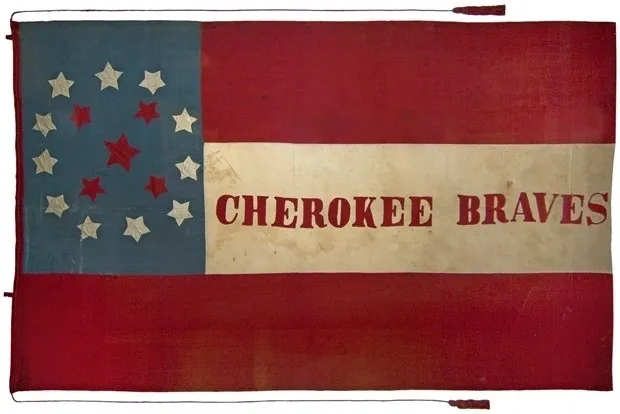
The DNA tests are not perfect and often due to such small percentages, the DNA reported as East Asian or Middle Eastern could actually be Native American. Most experts agree that less than 2% of a certain ethnicity, could be what is called, “DNA Noise”, and the pinpointing the exact group becomes a bit murky. So, if you see that you have 1% Sub-Saharan African in your DNA, it may not be true, it could be DNA noise, but if you have 0%, that is accurate. It is often helpful to test with multiple testing companies, and compare your results. This can sometimes help to eliminate DNA noise.
It is also possible that your Cherokee ancestor was raised by the Cherokee, but they themselves were all, or mostly European. Many Europeans were taken captive by Native Americans, especially at a young age and raised by the tribes. Some of them may not have even known that they were European. Your ancestor could have been raised Cherokee from a baby and later married a European and lived the rest of their lives in European settlements, never knowing that they weren’t racially a Cherokee in the first place.
Several Native American groups have refused to test and this makes finding your Native DNA a bit harder to identify. In addition to that, many of those that have tested are a large percentage European themselves, making it harder to identify the Native American markers.
There were many surveys and rolls made of the Cherokee beginning in the early 1800s. If in doing your family tree, you don’t find an ancestor listed in those roles, it is highly unlikely that they exist. You just are not Cherokee and sometimes that is a hard pill to swallow since you have heard the stories all your life.
You may be asking, okay, so I realize that I’m probably not Cherokee, but where did this family story come from? There are many theories as to where the myth came from and we will explain them.
The Cherokee have a long and celebrated history in what is now the United States, and throughout most of their history they have lived in Southern Appalachia, spanning modern Virginia, West Virginia, North and South Carolina, Tennessee, Kentucky, Georgia and Alabama. The tribe was made up of seven matrilineal clans, meaning that the individual claimed their identity from their mother’s clan. The Cherokee first began to interact with the European explorers and later settlers beginning in the mid 1500s.
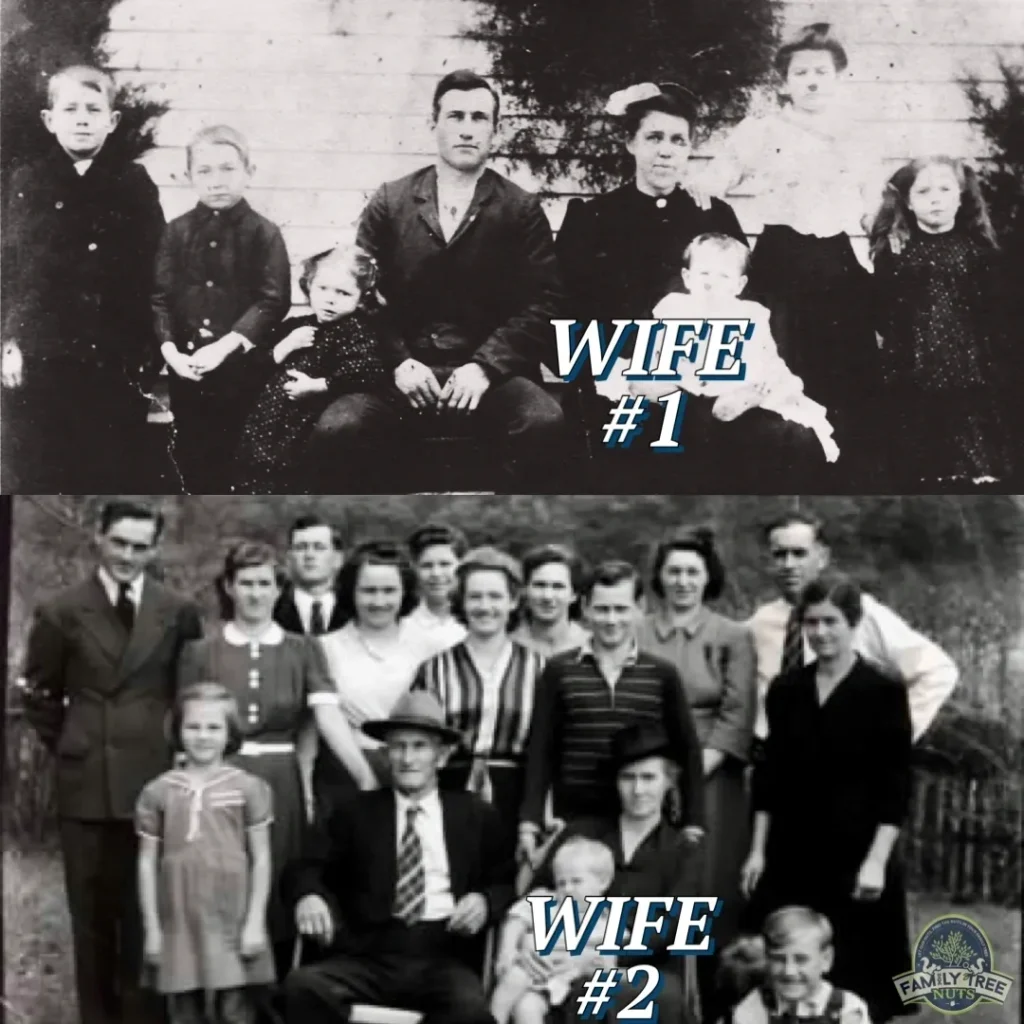
As European settlement grew, many of the Cherokee began to adapt their cultures to that of their new white neighbors. Marriages were encouraged with the European settlers, usually to men that spent most of their time hunting in the backwoods or lived on the fringes of European settlements. Many of those marriages were due to lack of European females on the fringes, but often the marriages were a product of alliances for trade and peace. By taking a Cherokee wife, a longhunter, or trader could have companionship but it often ensured a safer life in the back country. The marriages were beneficial for the Cherokee because it often helped them have better access to European tools and goods. Most of these marriages took place from the late 1600s, to the late 1700s, and rarely into the early 1800s. The Cherokee were often referred to as “The Civilized Tribe” because they were more apt to adapt to European ways than other tribes, and that is why more intermarriage between Europeans and Cherokee happened than with any other tribe.
It’s likely shocking to many, but in the late 1700s and into the early 1800s, many Cherokee purchased enslaved blacks. Modern estimates are variant but some estimates say that as many as fifteen percent of Cherokee families owned slaves. Through these circumstances, an unknown number of mixed Cherokee and African decent children were born. Those enslaved people and their offspring would have been present on The Trail of Tears. This is why so many Black Americans believe they have Cherokee ancestry, however they like the rest of Americans, very rarely have any Cherokee DNA.
The Cherokee fought against the government to be removed from their homes and sent to Oklahoma. However, after they were gone, their situation was often admired, and many in the south began to relate with their cause as the situation heated up before the Civil War. It was at this time in the 1840s and 1850s that many Southerners first began to claim to be descended from a Cherokee great-grandmother. Several of them claimed that their great-grandmother was a Cherokee Princess, even though the Cherokee never had a title or position resembling a princess in their culture.
This link to “royalty” solidified their claim as valid true children of the South and that like their Cherokee ancestors did before them, they must fight against the government that was oppressing them. They would often say things like, “we have got to fight against this corrupt government just like my ancestors have done for generations”. Claiming Cherokee ancestry gave them a feeling of true “Americanness” and definitely “Southerness”. The fact that many Cherokee fought for the Confederacy during the Civil War strengthened this bond.
Many people gain an identity from claiming Cherokee ancestry and they proudly profess to others about their Cherokee blood, while displaying and wearing symbols of native heritage. When asked, very few can identify their supposed Cherokee ancestor and they often say, “well, I’ve just always heard it”, “my Grandma told me”, or “my Grandma told me, whose grandma told her”.

This Cherokee ancestor is usually identified as one’s “Great-Great-Grandma who was full-blooded Cherokee”. Why is it so common to be one’s great-great-grandmother? My theory behind this is, is that many of us have at least some memory of our great-grandparents, but hardly anyone would have much knowledge about a great-great-grandparent. We get lost in the greats, and the person that we are referring to has been passed down through the ages as a great-great, when in reality, they are more like 5th-8th greats.
These stories and beliefs get passed down, over and over until they reach us and many of us simply accept them as fact. Some of these stories get muddied with step-siblings. Throughout the generations, many women passed away in childbirth, often leaving their husbands with several children to raise. Almost always the husbands remarried quickly and had another set of children with their second wife. Sometimes these stories stem from the ancestor of the first wife but the stories get combined and passed down by the descendants of the second wife.
We so often hear, “she looks Indian, she has jet black hair, high cheek bones, and a weathered face”. I have heard these statements all my life about old family photos of elderly women. The fact is, our ancestors rarely dyed their hair, and mainly lived hard primitive lives on remote farms. They were tough, strong, and determined which no doubt effected their appearances. However, we often see what we want to see and perception becomes reality. If we look at an old photograph and hope to see Cherokee resemblances, we likely will find them.
Ironically, due to so many Americans claiming Cherokee ancestry, it has helped the tribe to prosper. More outside money has been poured into their communities through investment and tourism than any other tribe. Cherokee is by far the most common tribe mentioned when claiming native ancestry but some other tribes that are often mentioned are Blackfoot, Creek, Shawnee, Choctaw, Sioux, and others.
Some of these claims make little sense when you understand geography and the history of the tribes. For example, it is highly unlikely for someone raised in the hills of West Virginia, along with several generations their ancestors, to have an ancestor that was a Blackfoot, which hail from Montana and Canada. However, this is a semi-common claim. Another theory is that some families with mixed white and black ancestry would explain their dark features as Cherokee, in order to avoid prejudice and discrimination. Many times, these folks believed that it was better to be an Indian, than to be black.
So, what do you think? Now that I have busted so many peoples bubble about their Cherokee ancestor not existing, I’m curious to hear your thoughts. Please leave a comment below of what you think, positive, or negative. I’m confident that many you will refuse to buy into what I’ve said, and will look for ways to refute it. So many of us have heard the myth of our Cherokee ancestors all of our lives, and literally get depressed when we find out that we don’t have a drop of anything but Northern European blood. Just because someone wants to be Cherokee, doesn’t make them Cherokee. No more than me wanting to be a billionaire, makes me one. Like I said earlier, be proud of who you are, and all of your ancestors. Find ways to celebrate them and they will become your true identity. Be sure to see the video below about this topic.
-Col. Russ Carson, Jr., Founder, Family Tree Nuts

